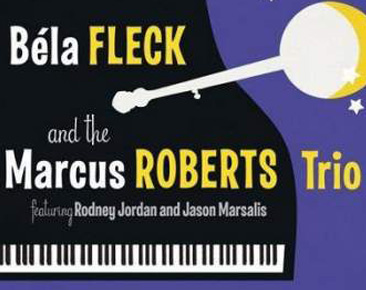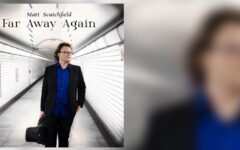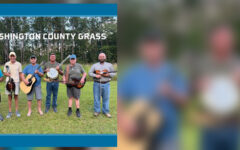
This review of the new project from Béla Fleck and the Marcus Roberts Trio is a contribution from David Hollender, professor at the Berklee College of Music in Boston. David teaches both banjo and upright bass at Berklee, and has many years of experience teaching and playing bluegrass, jazz and classical music. His new book, Beyond Bluegrass Banjo (with Matt Glaser), is published by Berklee Press.
 It is not unusual to see the label “jazz banjo” used to describe music that few jazz aficionados would consider to be jazz. I have no desire to get hung up on labels, but I will confess that copies of Béla Fleck’s CDs that may have won him Grammy’s for jazz categories are not shelved with my jazz CDs. His newest Rounder Records release, Crossing the Imaginary Divide, definitely belongs on the jazz shelf.
It is not unusual to see the label “jazz banjo” used to describe music that few jazz aficionados would consider to be jazz. I have no desire to get hung up on labels, but I will confess that copies of Béla Fleck’s CDs that may have won him Grammy’s for jazz categories are not shelved with my jazz CDs. His newest Rounder Records release, Crossing the Imaginary Divide, definitely belongs on the jazz shelf.
Béla thrives on jumping into uncharted waters and rising to the occasion. In the process he has opened many peoples minds about the banjo. Across the Imaginary Divide, finds him playing with the Marcus Roberts Trio. To my knowledge this is the first complete CD of five-string banjo playing with a jazz trio of piano, bass and drums; certainly the first with a trio that plays at this level.
Roberts came on the scene playing with Wynton Marsalis in 1985 and in 1987 placed first in the Thelonious Monk Jazz Piano competition. He is known for having strong roots in early jazz piano styles of players like Jelly Roll Morton, James P. Johnson, Duke Ellington and Monk.
Obviously, Fleck has deep roots and appreciation for tradition too. However, while early jazz did include banjo, it was used mainly as a rhythm instrument and Béla’s three-finger, five-string banjo playing bears little resemblance to those older styles. In this context he is forced to rely on his big ears, creativity, intuition, and exceptional technique to find ways to work with a pure jazz trio. As usual, he rises to the occasion using combinations of rolls, melodic and single-string techniques.
 Roberts and Fleck first met at a jam session at the Savannah Music Festival and discovered a compatibility that made them eager to play more and collaborate on this recording. Béla’s previous projects with jazz players include a tour with Stanley Clarke and Jean Luc Ponty and duets with Chick Corea. While those players all enjoy superstar status, I find the results on this CD to be much more satisfying.
Roberts and Fleck first met at a jam session at the Savannah Music Festival and discovered a compatibility that made them eager to play more and collaborate on this recording. Béla’s previous projects with jazz players include a tour with Stanley Clarke and Jean Luc Ponty and duets with Chick Corea. While those players all enjoy superstar status, I find the results on this CD to be much more satisfying.
Roberts’ trio has chemistry that comes from years of playing together. Drummer Jason Marsalis has played on all of Roberts group recordings since 1995, and Rodney Jordan has been the bassist for the trio since 2009. They are every bit on par with they best bass and drums combinations you’ll hear, providing a wide dynamic range, varied textures, and grooves that run the gamut from delicate to fiery.
The new CD consists of all new music; five tunes by Fleck, six by Roberts and one co-write. On half the tunes the arrangements hinge on metric modulations like changing time signatures, or going in and out of double-time feel. Sometimes this is a compositional device, other times it seems to be mainly used to offer each player a comfortable groove to solo over. As would be expected on a jazz project, everybody gets ample solo space. There is plenty of interplay when the piano and banjo trade improvised phrases, and on the title track they engage in some simultaneous improvisation over a chord progression that builds texturally and rhythmically off of Béla’s syncopated banjo rolls.
The first track, Some Roads Lead Home begins with Béla playing a pentatonic melody in triplets over a funky groove. Suddenly the band jumps into a fast jazz waltz for solos. Before it’s over the melody gets passed around and everybody gets to solo. This is one of many metric modulations the band uses on this set to construct the tunes or as a framework for solos.
On I’m Gonna Tell You This Story One More Time, Béla gets a different sound by playing sans picks, snapping the strings and sometimes muting the bridge to produce a sound that suggests a trumpet played with a plunger mute. The effect is a bit like of Donald Fagen’s (Steely Dan) guitar interpretation of the muted trumpet solo from the Duke Ellington classic, East St. Louis Toodle-Oo. Béla uses a similar sound on Let Me Show You What To Do, which starts out with two choruses of blues (in two different keys) over Jordan bowing a quasi-Latin bass line a la Cachao. When it is time to solo the band suddenly breaks into high energy double-time swing on a different set of changes, with Béla playing some hot lines based on diminished scales not often heard on banjo.
The closest thing to bluegrass banjo on this CD is on Petunia which is basically a blues with a bridge played in a gospel feel with a backbeat. One of the most exciting spots on the album comes near the end of this tune as Béla and Marcus are furiously soloing and trading phrases over Marsalis’ fiery groove.
The set includes two tunes with Brazilian grooves. Sunshine And The Moonlight is a bossa nova and Topaika is a samba. Béla’s delicate comping on the latter is so sweet you’d swear that Joao Gilberto played banjo. The haunting chords and floating time feel at the end of the phrases on the melody of Kalimba reminded this listener of a tune by Pat Metheny with Milton Nasamiento. Heading in a totally different direction, That Old Thing, by Fleck has a melody that could have been written by Cole Porter. The chords are basic for jazz but not the kind of diatonic or modal chords typical of traditional banjo music. Béla’s makes the changes and includes clear melodic development and sense of form. Roberts fondness for Thelonius Monk shows in his composition, Let’s Go, which features a fine bowed bass solo.
This CD may not appeal to every reader of Bluegrass Today. Some players and listeners like to stay close to their comfort zone, and that’s fine. As with any kind of music – jazz, classical, bluegrass, et al – what you hear it in it depends partly on understanding it in context.
This listener found a lot to like in this CD and hopes it will be just the first of more collaborations by these artists.







